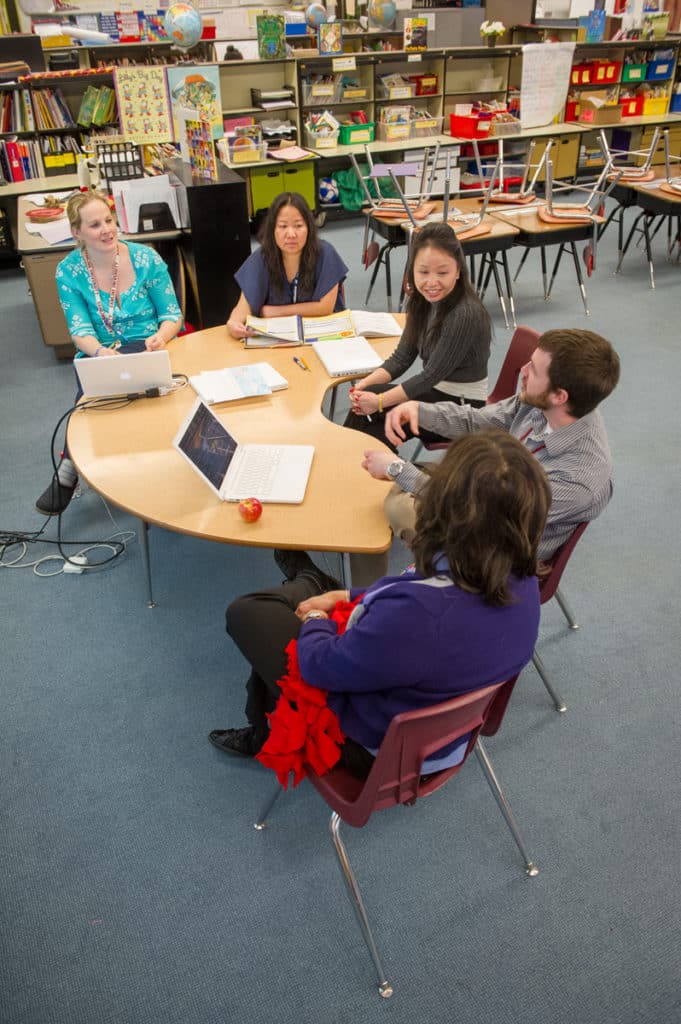
When each school in her district was required to convene a literacy team, Karen Casto, then principal of Penn Valley Elementary School, saw it as an opportunity for the whole school to learn together about reading. So, rather than selecting just a few individuals to be on the team, she asked all classroom teachers to participate. Starting in January 2004, the entire faculty gathered once a month before school to discuss readings from a text they had selected, practice literacy instruction strategies, share ideas about implementation, and reflect on what they’d tried so far.
Each of the literacy meetings gave teachers hands-on experience using practical approaches to improve reading comprehension. In one typical forty-five minute session, the teachers, after discussing the assigned reading, practiced applying the techniques they were learning about. They read a poem together, each pointing out where they used background knowledge, predicting, and visualizing as strategies for reading comprehension. The meeting ended with small groups talking about ways to teach reading comprehension across disciplines. The teachers seemed energized as they spilled out of the library, continuing to chat about what they’d learned as they moved on to a day in the classroom.
“The content of the sessions and the way they were run were models for what we could do in the classroom,” says Instructional Support Teacher Sue DeMeglio. “We learned active strategies and deepened our knowledge of how to enhance comprehension among our students.”
The literacy meetings are characteristic of the learning-focused professional development activities at Penn Valley Elementary. One reason the adults at this school can do such intensive intellectual work together is that they’ve built trust and collaborative skills over many years. “For any learning to take place, we have to feel safe,” says Karen, who emphasizes that this is as true for adults as it is for children. “Without safety, we won’t take risks or try new things. What I realized was that my job as principal was to build a community of safety and trust among adults, just as the teachers’ job was to build that community with the children.”
Building that trusting adult community was a long-term project, and part of the plan when Penn Valley Elementary decided to implement the Responsive Classroom approach schoolwide in 1996. As teachers began using Responsive Classroom strategies in their classrooms, Karen, teachers, and parents adapted some of those strategies for use with the school’s adults. They held voluntary adult Morning Meetings twice a month and spent the first six weeks of school developing ground rules for staff. In the mailroom, Karen posted morning messages in the style of News and Announcements charts. Teams of Penn Valley Elementary teachers attended workshops together, observed in each other’s classrooms, and formed study groups.
Now, teacher Nicole Peirce says, “Every conversation we have about teaching helps us with our practice. We are building a community where everyone feels they not only have the obligation to learn, but also have the opportunity and support they need to do it.”
Careful planning and pacing was another key to the success of the adults’ meeting times. Important guidelines included:
At Penn Valley Elementary, all meetings were scheduled as far in advance as possible. All literacy meeting dates, for example, were set at the beginning of the year. Sessions ended on time so teachers would not start the day feeling rushed.
The meetings gave teachers a chance to be learners, and to experience a sequence of activities designed to be just as engaging and varied as those they might devise for their own students. For example, a typical forty-five minute literacy meeting included partner exercises, whole group discussion, tasks requiring spoken and written responses, and small group conversations.
Teachers had time during meetings to consider what happened when they tried new things in the classroom. They might do this by responding in writing, exploring a topic with a partner, or discussing an issue as a large group. The key, Karen says, is giving teachers permission to say “this isn’t working” and helping them feel comfortable talking about mistakes as well as successes.
Ten years of focused adult community work such as the literacy meetings have brought dramatic positive changes in instruction, school culture, and achievement to Penn Valley Elementary. Karen, who retired in 2005, says, “We really have become a community of learners, and being able to see that change take place was really rewarding.”
Setting: Suburban
Grades: K to 5
Number of students: 400
% of students eligible for free or reduced-price lunch: 19%
Full-time staff: 49 teachers; 16 support, administrative, and office staff